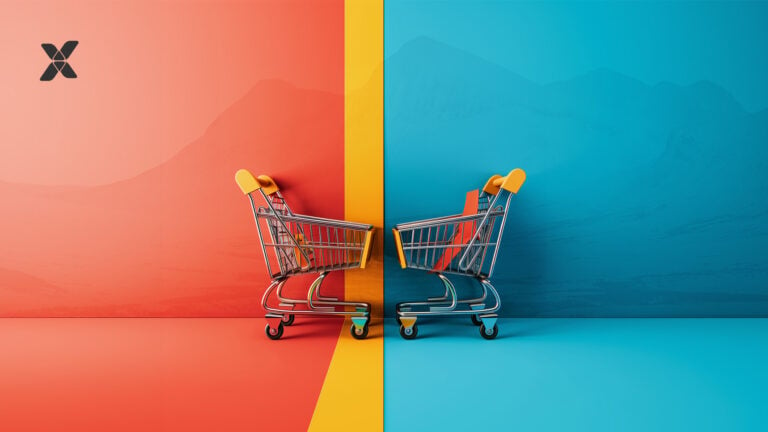In biology, evolution is defined as the change in the characteristics of a species over several generations—the gradual development of something. In business and retail, the definition has traditionally been the same. However, with digital commerce and its breakneck rate of change, retail evolution is happening at an even more rapid pace.
Several years ago I went on TV (a local morning business show in San Francisco), talking about the future of retail—how traditional retail needed to become more mobile, get better at in-store assistance and focus on providing better overall ecommerce experiences. At the time, retail evolution was lagging behind changing consumer behavior. Now, however, it is catching up, accelerated by the “forced trials” of COVID-19.
So, what are the latest developments in the evolution of retail, and what are the 2021 retail trends to consider heading into 2022?
Related reading: Ecommerce Trends: 2022 Outlook
Wayfinding
We have all experienced the frustration of not finding something quickly at a retail store. And COVID-19 has created even greater expectations for the efficiency of shopping. This is where consumer expectations are often going unmet—better interactions while in the store and higher efficiency in directing customers to exactly what they are looking for.
Brick-and-mortar stores are no longer stand-alone entities. The vast majority of customers use multiple channels during one purchasing journey, and a combined physical and digital presence can help brands drive impact by 32%. Digital wayfinding is crucial to allow your customers to follow their own path while anticipating their desire to create a great customer experience and build trust with consistent messaging and personalized promotions.
Related reading: What is Omnichannel Retailing
Cashierless Check-out
Cashierless check-out has exploded in the last couple of years, especially in grocery stores. The first Amazon Go opened in downtown Seattle in 2018. Amazon Go is completely cashierless; cameras and sensors detect that you have walked in, when you have removed items from shelves, and the payment is taken through Amazon Prime via the mobile app. But where are other retailers with this concept?
COVID-19 has driven the popularization of cashierless check-outs, with the need to minimize human-to-human interaction. Start-ups are offering new contactless payment options as well as grab-and-go shopping solutions, where customers can walk into a store, and simply leave with their purchases, being automatically charged as they exit. The future of retail is likely more cashless and cashierless.
Direct to Consumer (D2C)
Direct to consumer is making a move from online to physical—once digital-only brands are opening stores that offer great in-store experiences that reflect the online brand. Allbirds, Warby Parker, Everlane—are all forerunners for this next step in the retail evolution.
Retail evolution is happening at full speed and tracking developments in D2C can be a great way to keep up with it—it allows you to enter the market quickly and with a lower entry-level cost. With D2C ecommerce sales booming, and D2C brands successfully opening brick-and-mortar stores, for select brands, D2C will be the best digital commerce business model for the future!
Related reading: Digital Commerce Business Models: The Current Landscape
Quid Pro Quo of Wearables
We continue to see the wearables trend disrupting healthcare—tracking health problems, managing diet and fitness, and reminding patients when to take the meds. These wearable devices collect large amounts of information that people are happy to share. According to Deloitte, about half of the people who use a fitness or health monitoring device, have shared their data with a doctor for the prospect of better health outcomes.
If people are willing to share their health data to get better outcomes, would the same be true for shopping? Is retail evolving to include valuable data from wearables, where this quid pro quo for data could work as well?
Video Assistance
As with sharing healthcare data from wearables, people are also getting more used to virtual healthcare visits. COVID-19 was a massive forced trial for video consultations from doctors and specialists, especially for Gen X and Baby Boomers, whose virtual healthcare visits increased respectively 7% and 5%.
Does this change in people’s habits and behaviors also affect their shopping behavior? Will video commerce become the next big evolution in retail? For example, video shopping sessions with a salesperson could lead to higher conversion and much more interaction with the brand.
Livestream ecommerce—basically the QVC version of the digital commerce experience—is already immensely popular in Asia, with hundreds of millions of people watching shopping livestreams in China. In the U.S., Amazon has launched an in-house QVC platform, and Walmart has tested live shopping on TikTok. So, livestream ecommerce is clearly taking off. It is likely that other ways to use video, including video shopping assistance, in retail will follow suit.
Related reading: Livestream Ecommerce is the Future of Shopping
|
Want more advice on this topic? |
One-click Checkout
Amazon has been using one-click checkout since 1999 and the patent for their one-click buying process expired in 2017, so how is this not table stakes in 2021?
One-click checkout makes buying fast and easy, reduces fraud, and creates a branded experience throughout the whole customer journey. According to Bolt, allowing shoppers to breeze through the checkout experience with one click generates up to 60% higher conversions. One-click checkout will likely be the most adopted trend in retail evolution going into 2022.
The QR Code
Taking a picture of your check with your banking app was a game-changer for the banking industry. For the retail industry, the same may be said for the QR code, although the adoption has in retail has been slow and clunky. The QR code is a bridge between the digital and physical worlds for retailers.
QR codes in retail are so much more than just accessing a website; they can be used to engage customers, communicate corporate responsibility, aid wayfinding, and facilitate payments. QR codes are the future of creating enriched consumer retail experiences and represent true digital transformation and not just digitizing for retailers.
Related reading: The Role of QR Codes in Your Ecommerce Strategy
Notifications
We all know how Pavlovian we have become when it comes to notifications—that buzz or little red dot lets us know that something really important has happened and that we must check it out. Notification while near the retail store, prompts 53% of shoppers to visit, 50% of those visits, having been unplanned.
Many retailers are already using notifications to their advantage and this number will likely only increase. But a more strategic approach to using notifications is a must for retail to continue to evolve.
Product Interaction
A couple of years ago, product videos would have made little difference to your customers. Now, however, product videos—an easy way to improve product interaction—are becoming an integral part of ecommerce.
I was recently browsing on the commerce site of a popular outdoor company and came across a rain jacket I liked. With the product worth well over $380 and no product video, I felt uncomfortable making such a relatively expensive purchase based on a 100-word description. I am not alone in this, one client we work with found that products over a certain price point, convert at 2.5 times when they have a product video.
Product interaction—at the very least video, 3D pictures, and Augmented Reality (AR)—is now a crucial part of customer experience. Your customer expects to be able to interact with your products, to get a detailed view from whichever angle they choose, or to use AR to make sure your product fits just right. To keep pace with the rapid retail evolution, providing more options for product interaction is crucial.
Ship-from-store
Retail giant Target is using a store-based fulfillment model where the vast majority of orders are shipped from the store level. They say this allows its inventory to be more productive and fulfill orders more effectively. The same-day services from Target, including pickup, drive-through, and Shipt, grew 212% in 2020, compared to 2019. And they are planning on investing even more towards this supply chain overhaul.
While ship-from-store is driven by logistics, it is a clear example of meeting consumer expectations for speed of delivery and more delivery options. Many companies will likely implement similar strategies to Target, to make the most of this trend in retail evolution.
Key Takeaways
Consumer expectations are evolving at a breakneck pace. Retailers need to develop at the same speed to meet those expectations. Adopting emerging 2021 trends, like ship-from-store or cashierless checkouts, will help you stay at the front of the pack as we head into 2022. Keep an eye on these trends as the retail evolution continues and more opportunities for a refined digital commerce strategy emerge.
How Vaimo Can Help
At Vaimo, we have experience working with various B2B companies in building their digital commerce solution. We’re a full-service omnichannel partner and can help you with every part of the process—from strategy, design, development, and managed services. Get in touch to talk to one of our experts.








